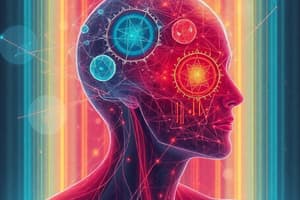Podcast
Questions and Answers
What is the correct order of the phases in a memory task?
What is the correct order of the phases in a memory task?
- Consolidation, Encoding, Retrieval
- Encoding, Retrieval, Consolidation
- Retrieval, Encoding, Retention
- Encoding, Retention, Retrieval (correct)
Which type of memory includes procedural memory?
Which type of memory includes procedural memory?
- Implicit memory (correct)
- Episodic memory
- Semantic memory
- Explicit memory
What is the primary function of the short-term memory (STM)?
What is the primary function of the short-term memory (STM)?
- To store unlimited information for long periods
- To encode sensory information directly for memory
- To rehearse important information for longer retention (correct)
- To provide immediate and permanent storage
Which of the following is NOT a method used to examine memory?
Which of the following is NOT a method used to examine memory?
During which memory phase is information lost if not attended to?
During which memory phase is information lost if not attended to?
What type of information is classified as echoic?
What type of information is classified as echoic?
Which part of the Atkinson and Shiffrin model is responsible for the temporary storage of sensory information?
Which part of the Atkinson and Shiffrin model is responsible for the temporary storage of sensory information?
Which statement is true regarding long-term memory (LTM)?
Which statement is true regarding long-term memory (LTM)?
Which statement correctly differentiates episodic and semantic memory?
Which statement correctly differentiates episodic and semantic memory?
What was the primary limitation found in Averbach's replication of Jevon's experiment?
What was the primary limitation found in Averbach's replication of Jevon's experiment?
In Sperling's 1960 experiment, what conclusion can be drawn about iconic memory?
In Sperling's 1960 experiment, what conclusion can be drawn about iconic memory?
What does the term 'decay' refer to in the context of iconic memory?
What does the term 'decay' refer to in the context of iconic memory?
Which research question raised by Nairne in 2003 challenges the conventional model of sensory memory?
Which research question raised by Nairne in 2003 challenges the conventional model of sensory memory?
What happens to information in short-term memory (STM) if it is not rehearsed?
What happens to information in short-term memory (STM) if it is not rehearsed?
Which phenomenon explains why people remember the first items in a list better than those in the middle?
Which phenomenon explains why people remember the first items in a list better than those in the middle?
What is a characteristic of the recency effect in memory recall?
What is a characteristic of the recency effect in memory recall?
Which type of amnesia is characterized by the inability to form new memories following a trauma?
Which type of amnesia is characterized by the inability to form new memories following a trauma?
Which component of Baddeley and Hitch's working memory model is responsible for monitoring and controlling the storage systems?
Which component of Baddeley and Hitch's working memory model is responsible for monitoring and controlling the storage systems?
Neurophysiological studies on patients with medial temporal lobe damage show that they have which of the following abilities?
Neurophysiological studies on patients with medial temporal lobe damage show that they have which of the following abilities?
Evidence suggesting that STM might have more than one system is primarily supported by problems observed in which task type?
Evidence suggesting that STM might have more than one system is primarily supported by problems observed in which task type?
Which type of information is retained better in the visuospatial sketchpad compared to the phonological loop?
Which type of information is retained better in the visuospatial sketchpad compared to the phonological loop?
What does the Dual Task Paradigm suggest about verbal and visuospatial information?
What does the Dual Task Paradigm suggest about verbal and visuospatial information?
According to Della Sala et al. (1999), how should the visuospatial unit be categorized?
According to Della Sala et al. (1999), how should the visuospatial unit be categorized?
What does the phonological similarity effect indicate about memory recall?
What does the phonological similarity effect indicate about memory recall?
What happens to the word length effect when rehearsal is suppressed?
What happens to the word length effect when rehearsal is suppressed?
How does Baddeley's definition of the central executive differ from others?
How does Baddeley's definition of the central executive differ from others?
What new component did Baddeley introduce to the working memory model in 2000?
What new component did Baddeley introduce to the working memory model in 2000?
In the context of memory models, what does the dual component model propose?
In the context of memory models, what does the dual component model propose?
Which alternative view of short-term memory suggests it's part of long-term memory?
Which alternative view of short-term memory suggests it's part of long-term memory?
What characterizes the transition of information from episodic to semantic memory?
What characterizes the transition of information from episodic to semantic memory?
What does the concept of 'memory savings' imply in the context of learning?
What does the concept of 'memory savings' imply in the context of learning?
Which of the following best describes the findings related to spaced learning?
Which of the following best describes the findings related to spaced learning?
According to the forgetting curve, how is the retention of information affected over time?
According to the forgetting curve, how is the retention of information affected over time?
What best describes the trend observed in Bahrick's research regarding recognition over time?
What best describes the trend observed in Bahrick's research regarding recognition over time?
What does the power equation proposed by Wixted suggest about information retention?
What does the power equation proposed by Wixted suggest about information retention?
How does the approach of retrieval practice differ from additional learning sessions?
How does the approach of retrieval practice differ from additional learning sessions?
Which factor is NOT considered to influence how long a person can remember personal experiences, according to Rubin et al.?
Which factor is NOT considered to influence how long a person can remember personal experiences, according to Rubin et al.?
Ebbinghaus's research primarily utilized what type of information for his studies?
Ebbinghaus's research primarily utilized what type of information for his studies?
What was the recognition rate found by Standing when presenting pictures and printed words?
What was the recognition rate found by Standing when presenting pictures and printed words?
What distinguishes implicit memory from explicit memory?
What distinguishes implicit memory from explicit memory?
According to Konkle et al., how does the category size affect memory performance?
According to Konkle et al., how does the category size affect memory performance?
What does the retention curve for autobiographical memories suggest about memory decline?
What does the retention curve for autobiographical memories suggest about memory decline?
What finding associated with identification memory was noted by Bahrick et al. after eight years?
What finding associated with identification memory was noted by Bahrick et al. after eight years?
What phenomenon explains the tendency of adults to remember past experiences associated with their adolescence?
What phenomenon explains the tendency of adults to remember past experiences associated with their adolescence?
Which statement about spaced learning versus mass learning is correct?
Which statement about spaced learning versus mass learning is correct?
Which equation describes the retention of information according to Wixted?
Which equation describes the retention of information according to Wixted?
According to the forgetting curve, how does information retention change over time?
According to the forgetting curve, how does information retention change over time?
Flashcards
Memory
Memory
The ability to acquire, store, retrieve, and retain information.
Explicit Memory
Explicit Memory
Memories that can be expressed in words, like facts or events.
Implicit Memory
Implicit Memory
Memories that cannot be expressed in words, like skills or habits.
Encoding
Encoding
Signup and view all the flashcards
Retention
Retention
Signup and view all the flashcards
Retrieval
Retrieval
Signup and view all the flashcards
Free Recall
Free Recall
Signup and view all the flashcards
Cued Recall
Cued Recall
Signup and view all the flashcards
Episodic memory
Episodic memory
Signup and view all the flashcards
Semantic memory
Semantic memory
Signup and view all the flashcards
Iconic memory
Iconic memory
Signup and view all the flashcards
Memory capacity
Memory capacity
Signup and view all the flashcards
Memory duration
Memory duration
Signup and view all the flashcards
Rehearsal in STM
Rehearsal in STM
Signup and view all the flashcards
Primacy Effect
Primacy Effect
Signup and view all the flashcards
Recency Effect
Recency Effect
Signup and view all the flashcards
Anterograde Amnesia
Anterograde Amnesia
Signup and view all the flashcards
Retrograde Amnesia
Retrograde Amnesia
Signup and view all the flashcards
Visuospatial Sketchpad
Visuospatial Sketchpad
Signup and view all the flashcards
Phonological Loop
Phonological Loop
Signup and view all the flashcards
Central Executive
Central Executive
Signup and view all the flashcards
Dual Task Paradigm
Dual Task Paradigm
Signup and view all the flashcards
Phonological Similarity Effect
Phonological Similarity Effect
Signup and view all the flashcards
Word Length Effect
Word Length Effect
Signup and view all the flashcards
Episodic Buffer
Episodic Buffer
Signup and view all the flashcards
Dual Component Model of Working Memory
Dual Component Model of Working Memory
Signup and view all the flashcards
Spatial Interference
Spatial Interference
Signup and view all the flashcards
Memory Savings
Memory Savings
Signup and view all the flashcards
Mass Learning
Mass Learning
Signup and view all the flashcards
Spaced Learning
Spaced Learning
Signup and view all the flashcards
Retrieval Practice (Testing Effect)
Retrieval Practice (Testing Effect)
Signup and view all the flashcards
Memory Retention
Memory Retention
Signup and view all the flashcards
Recognition Memory
Recognition Memory
Signup and view all the flashcards
Identification Memory
Identification Memory
Signup and view all the flashcards
Articulatory Suppression Effect
Articulatory Suppression Effect
Signup and view all the flashcards
Childhood Amnesia
Childhood Amnesia
Signup and view all the flashcards
Recognition Test
Recognition Test
Signup and view all the flashcards
Conceptual Memory
Conceptual Memory
Signup and view all the flashcards
What are the two types of explicit memory?
What are the two types of explicit memory?
Signup and view all the flashcards
What is memory savings?
What is memory savings?
Signup and view all the flashcards
Describe the forgetting curve.
Describe the forgetting curve.
Signup and view all the flashcards
What is the power equation for retention?
What is the power equation for retention?
Signup and view all the flashcards
Reminiscence Bump
Reminiscence Bump
Signup and view all the flashcards
Recognition tasks
Recognition tasks
Signup and view all the flashcards
Study Notes
Memory Processes
- Memory involves acquiring, storing, retrieving, and retaining information.
- Explicit (declarative) memories are expressed verbally.
- Implicit (non-declarative) memories are not expressed verbally; these include priming, conditioning, and procedural memories (e.g., walking, swimming).
- Memory processes include encoding (creating), retention (storing), and retrieval (accessing).
- Memory examination methods include free recall, cued recall, and recognition.
- Memory tasks have three phases: learning/encoding, consolidation/retention, and retrieval/testing.
Memory Models
- The Atkinson-Shiffrin model (1968) outlines three memory systems: sensory memory, short-term memory (STM), and long-term memory (LTM).
- Sensory memory briefly holds incoming information. Unattended information is lost. Visual (iconic) and auditory (echoic) sensory memory exist.
- Short-term memory (STM) temporarily holds information (seconds to minutes). Rehearsal is crucial. STM has limited capacity. Information not rehearsed is lost.
- Long-term memory (LTM) stores information for extended periods. LTM has unlimited capacity. Information can be lost if not retrieved regularly.
- Information in sensory and STM is episodic, recording when and where the information was learned.
- Information in LTM can be episodic or semantic. Semantic memory stores information without remembering its context.
- The serial position effect (primacy and recency effects) suggests that rehearsal is important for transferring information from STM to LTM.
- Primacy effect: Better recall of items at the beginning of a list, due to rehearsal and transfer to LTM.
- Recency effect: Better recall of items at the end of a list, due to being in STM at recall. Recency effect disappears with delay.
- Neurophysiological evidence supports this modal memory. Patients with medial temporal lobe (MTL) damage have intact STM but cannot transfer new information to LTM (anterograde amnesia).
- Other research suggests models of STM need refinement due to different components of STM.
Sensory Memory (Iconic Memory)
- Iconic memory (visual) holds a large amount of visual information briefly. Duration is very short.
- Capacity and duration are critical aspects of iconic memory.
- Jevon (1963) and Averbach (1963) investigated iconic memory capacity. Picture complexity and presentation speed limit it (e.g., up to 8 items).
- Sperling (1960) demonstrated iconic memory's large capacity and rapid decay (masking/interference). The image is initially available, fading quickly.
- Langaman et al. (2003) suggested longer iconic memory durations (1600ms).
- Issues linger if sensory memory is a separate system or part of STM.
Short-Term Memory (STM)
- STM tasks include digit span (verbal) and Corsi (visual-spatial).
- Working Memory Model (Baddeley and Hitch, 1970): STM is complex, with multiple components.
- Visuospatial Sketchpad: Temporary visual and spatial storage. Shows better performance for visual-spatial tasks (Brooks, 1967). Dual tasks (e.g., mental rotation, rotor pursuit) suggest separate visual spatial and verbal systems.
- Phonological Loop: Temporary storage for verbal information. Supported by phonological similarity effect (Conrad & Hull, 1964), and word-length effect (Baddeley et al., 1975).
- Central Executive: Control center, prioritizing information and allocating it to components. A supervisory attention system (Norman & Shallice, 1982), controlling behavior, and distributing attention.
- Episodic Buffer: Added component to account for LTM influence on STM. Accounts for chunking, and better sentences recall. Temp storage from multiple cognitive systems.
- Alternative models of STM include embedded process, feature, and dual component model, as well as simpler models viewing STM and LTM as similar.
Long-Term Memory
-
Information remembered for more than a few minutes is long-term memory.
-
Explicit LTM includes episodic memory (events) and semantic memory (facts). Explicit initially is episodic, but over time becomes semantic as context is forgotten.
-
Implicit LTM includes procedural memory (skills), conditioning, and priming.
-
Ebbinghaus pioneered LTM research, measuring relearning times. Memory savings (faster relearning) decreases with time between learning sessions.
-
Spaced learning is superior to massed learning (one study session), and retrieval practice (testing) boosts recall more than additional learning.
-
The forgetting curve describes information retention/recall decline over time. Initial rapid forgetting is followed by a slower decline, with some information remaining.
-
Wixted (1990, 1997) modeled forgetting using a power equation (y=ax^-b).
-
Bahrick’s (1984) research on Spanish vocabulary learning revealed an initial rapid decline in retention, followed by stabilization.
-
Bahrick et al. (1975) studied professor-student face recognition. Recognition declined less than recollection (no choices/options); recognition followed the forgetting curve (rapid initial decline, followed by stabilization), whereas identification (no choices) decreased substantially over time.
-
Rubin and Wenzel (1996) demonstrated a power function’s accuracy in describing the decline of autobiographical memory.
-
Rubin et al. (1986) examined factors affecting autobiographical memory, including childhood amnesia (difficulty recalling early childhood) and the reminiscence bump (strong recall of adolescence/early adulthood).
-
Memory of language, faces, and personal experiences share similar forgetting trends to nonsense syllables.
-
Standing (1973) found higher recognition rates for pictures than words.
-
Konkle et al. (2010) discovered superior image recall when foils are from different categories. General concepts are retrieved more efficiently than detailed images.
Studying That Suits You
Use AI to generate personalized quizzes and flashcards to suit your learning preferences.




